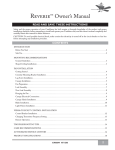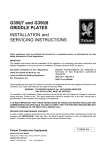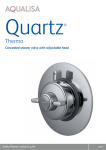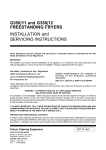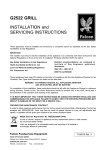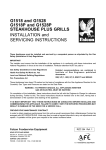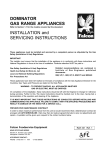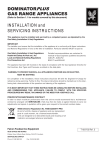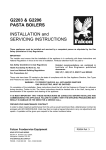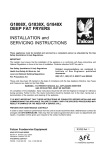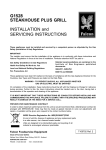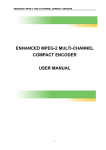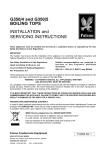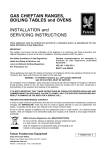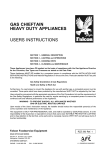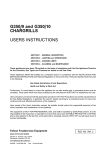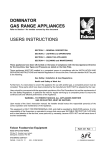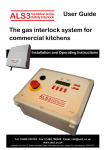Download G1532 STEAKHOUSE GRILL
Transcript
G1532 STEAKHOUSE GRILL INSTALLATION and SERVICING INSTRUCTIONS These Appliances must be installed and serviced by a competent person as stipulated by the Gas Safety (Installation & Use) Regulations. IMPORTANT The installer must ensure that the installation of the appliance is in conformity with these instructions and National Regulations in force at the time of installation. Particular attention MUST be paid to - Gas Safety (Installation & Use) Regulations Health And Safety At Work etc. Act Local and National Building Regulations Fire Precautions Act Detailed recommendations are contained in Institute of Gas Engineers published documents : IGE/ UP/ 1, IGE/ UP/ 2, BS6173 and BS5440 These Appliances have been CE-marked on the basis of compliance with the Gas Appliance Directive for the Countries, Gas Types and Pressures as stated on the Data Plate. WARNING - TO PREVENT SHOCKS, ALL APPLIANCES WHETHER GAS OR ELECTRIC, MUST BE EARTHED On completion of the installation, these instructions should be left with the Engineer-in-Charge for reference during servicing. Further to this, The Users Instructions should be handed over to the User, having had a demonstration of the operation and cleaning of the appliance. IT IS MOST IMPORTANT THAT THESE INSTRUCTIONS BE CONSULTED BEFORE INSTALLING AND COMMISSIONING THIS APPLIANCE. FAILURE TO COMPLY WITH THE SPECIFIED PROCEDURES MAY RESULT IN DAMAGE OR THE NEED FOR A SERVICE CALL. PREVENTATIVE MAINTENANCE CONTRACT In order to obtain maximum performance from this unit we would recommend that a Maintenance Contract be arranged with FALCON SERVICE LINE. Visits may then be made at agreed intervals to carry out adjustments and repairs. A quotation will be given upon request to the FALCON SERVICE LINE contact numbers below. Falcon Foodservice Equipment HEAD OFFICE AND WORKS PO Box 37, Foundry Loan, Larbert. Stirlingshire. Scotland. FK5 4PL AFE SERVICE LINE CONTACT PHONE - 01438 751111 FAX - 01438 369900 RZZ 84 Ref. 2 SECTION 1 - INSTALLATION UNLESS OTHERWISE STATED, PARTS WHICH HAVE BEEN PROTECTED BY THE MANUFACTURER ARE NOT TO BE ADJUSTED BY THE INSTALLER 1.1 MODEL NUMBERS, NETT WEIGHTS and DIMENSIONS MODEL G1532 WIDTH DEPTH HEIGHT WEIGHT GAS (mm) (mm) (mm) (kg) CONN. 784 330 350 36 Rp1/2 The grill may be mounted on any of the following options - Bench Legs. Floor Stand Wall Bracket 1.2 SITING There must be 150mm clearance all round the appliance from any combustible wall or object liable to damage when overheated. There must be a minimum vertical clearance of 900mm above the top edge of the grill flue to ensure No overheating of overlying surfaces. A minimum clearance of 400mm from the sides should be provided to allow removal of outer panels for service access. Note The upper sections of the unit are likely to become very hot. It should therefore be positioned in a manner which minimises the risk of accidental touching. 1.3 VENTILATION The grill MUST be installed level in a well lit and draught free position. Adequate ventilation, whether natural or mechanical, must be provided to ensure sufficient air for combustion and removal of combustion products, which may be harmful to health. Recommendations for Ventilation of Catering Appliances are given in BS5440:2. Furthermore, to ensure sufficient room ventilation, guidance on the volume of ventilation air required for different types of catering equipment is provided in the following table. For multiple installations, requirements for individual appliances should be added together. Installation should be made in accordance with local and/or national regulations applying at the time. The grill flue discharges vertically from the top of the unit. There must be no direct connection of the flue to a mechanical extraction system or the outside air. Positioning the grill below a ventilated canopy is the most suitable arrangement. EQUIPMENT Range, Unit Type Pastry Oven Fryer Grill Steak Grill Boiling Pan Steamer Sterilizing Sink Bains Marie Tea/ Coffee Machine Ventilation Rate Required m3/ min ft3/min 17 17 26 17 26 17 17 14 11 8.5 - 14 1.4 GAS SUPPLY 600 600 900 600 900 600 600 500 400 300 - 500 The incoming service must be of sufficient size to supply the full rate without excessive pressure drop. A gas meter is connected to the service pipe by the Gas Supplier. An existing meter should be checked, preferably by the Gas Supplier, to ensure that it is adequate to cope with the rate of gas supply required. Installation pipes should be fitted in accordance with IGE/UP/2. The pipework size, from the meter to the unit, must not be less than the appliance inlet connection, Rp1/4 (1/4" BSP). An isolating cock must be located close to the appliance (on the inlet side of the governor on Natural Gas models) to allow shut down during an emergency or routine service. The installation MUST BE TESTED FOR GAS SOUNDNESS, details of which can be found in IGE/UP/1. 1.5 ELECTRICAL SUPPLY Not applicable to this appliance. 1.6 WATER SUPPLY Not applicable to this appliance. 1.7 HEAT INPUTS NATURAL and PROPANE GAS GAS RATE kW Btu/hr 6.65 22,600 2.1.2 Bench Legs Assembly 1.8 INJECTOR DIAMETERS Natural and Propane Gas NATURAL PROPANE Main Burner 2.05mm Amal 210 Pilot Burner SIT No.30 SIT No.19 1.9 SETTING PRESSURE NATURAL PROPANE mbar 15 37 inches w.g. 6 14.8 A spring loaded governor, supplied with the appliance MUST BE FITTED to natural gas models. No governor is required on propane models. A pressure test point is accessible upon removal of the control panel. Bench legs when supplied, must be fitted to the underside of the grill using the screws and washers provided (see Figure 1). It is recommended that the legs be fitted at the start of assembly and that the operation is facilitated by placing the grill on its back. Each foot is secureded by two fixings. Use Holes 1 and 3 as indicated in each sketch. The leg locating brackets are then secured to the worktop surface using woodscrews or bolts as appropriate. The fixing hole centres are indicated in the diagram above. The brackets should be rotated to ensure that the threaded hole corresponds with the side fixing hole in each leg. The grill is then lifted into the brackets up inside the tubular legs. Each leg is then secured to a respective bracket using the fixings provided. 1.10 BURNER ADJUSTMENT Burner Aeration The burners are fitted with fixed injectors. The aeration is adjustable by means of a screw which is positioned at the burner inlet. After setting the pressure, the stability of the cones should be checked. If necessary, the aeration screw should be adjusted to achieve satisfactory cross lighting of the burners on both HIGH and LOW settings. This will also prevent yellow tipping of the flame or lift-off. SECTION 2 - ASSEMBLY and COMMISSIONING 2.1 ASSEMBLY 2.1.1 Grill Unit Unpack the grill and check that all components are undamaged. Parts supplied loose are specified in the contents list below Brander Drip Trough Brander Plate Grid Shelf Drip Tray Gas Governor (Natural Gas only) Additionally, 6 refractory plaques, 4 centre support bars of double construction and 4 end support bars. Appliance Mounting Accessories Details of the various grill mounting options are detailed in section 1.1. Individual Check Lists for Mounting Options Bench Legs Pack contains 4 legs and screw pack in polythene bag. Figure 1 Wall Bracket Floor Stand Carton contains Carton contains Bracket and screwpack. A - LH Support (1 off) Note - Rawlplugs and woodscrews are NOT B - Back Skirt (2 off) supplied C - Top Shelf (1 off) 2.1.4 Wall Bracket Mounting Instructions D - RH Support (1 off) E - Bottom Shelf (1 off) F - Upper Panel (1 off) G - Adjustable Feet (4 off) and the following fixings - M5 x 10mm Hex Screws (22 off), M5 Hex Nuts (4 off) and M5 Shakeproof Washers (18 off) Figure 3 Figure 2 2.1.3 Floor Stand Assembly Instructions a) Lay the two end supports (A & D) on their backs on the floor. Slip the bottom shelf (E) over the cross bars and secure through the side flanges into the holes in the cross bar. b) Slip the shelf (C) between the vertical tubes and secure through the flanges into the holes in the inside of the tubes. c) Raise the partly assembled stand on to its feet and from the rear, place the two back skirts (B) between the rear using the nuts and bolts provided. d) Lift the grill and position it carefully on top of the assembled stand. Secure in position through the two holes in the centre of the upper panel (F). The installer must make sure that the wall on which the grill is to be mounted is suitable to carry the unit weight and can be suitably plugged to take No. 8 woodscrews of a minimum length. Using the shelf as a template, hold it against the wall at the required height. Whilst maintaining the top surface horizontal, mark fixing screw positions. Remove the shelf and drill the wall to accomodate suitable plugs for No. 8 screws. Firmly secure the shelf in position. Place the grill on the shelf and place screws through holes numbered 6 to corresponding holes in the frame of the grill. 2.1.5 Assembly of Support Bars and Plaques a) Remove the enamelled facia by undoing the fixings which secure it at the bottom edge. Ease the panel forward at the bottom and lift it clear of the hidden location screws. b) Remove the top panel by undoing the two fixings at the rear and slide the panel backward, clear of the front location. c) Remove the inner top panel to expose the burners. d) Place the cast iron support bars between the burner and the front and rear locating slots. Insert the bars with the lugs facing upwards. This will enable the plaques to be held in position against the burner, see Figure 4. Note LOW FLAME position is set at factory. Re-setting is NOT necessary. 2.5.3 Soundness Checking and Re-assembly e) Carefully place the plaques on their support bars with the pips pointing downward. Ensure they are properly located and that they lay flat on the bars. f) Replace the inner top panel and ensure that it is properly positioned and located over the cast iron compartment sides. g) Replace the outer top panel. Whilst the grill is lit, test all integral gas carrying joints and components for soundness. Use a suitable leak detection fluid (i.e. Soap Solution). TURN OFF the gas control tap. REMOVE the pressure gauge and replace the test point sealing screw. ENSURE THAT A GAS TIGHT JOINT IS MADE. Re-assemble all panels and components removed during the installation and commissioning. The drip tray, wire grid and brander can then be placed in position. 2.2 CONNECTION TO THE GAS SUPPLY 2.6 INSTRUCTION TO USER Figure 4 Installation should be carried out in accordance with the various regulations listed on the cover of this document. On NATURAL gas appliances, the adjustable governor supplied, MUST be fitted to the gas circuit and securely fixed in a position which enables adjustment to be carried out during commissioning. PROPANE appliances do not require a governor. Ensure that a gas Isolating cock is fitted to the supply at a convenient proximity to the grill. 2.3 CONNECTION TO AN ELECTRICAL SUPPLY Not applicable to this appliance. 2.4 CONNECTION TO A WATER SUPPLY Not applicable to this appliance. 2.5 COMMISSIONING 2.5.1 Testing and Purging Pressure test the gas installation for soundness and purge any air from the supply. 2.5.2 Gas Pressure and Burner Flame Adjustment a) Remove the RH Side Panel. b) Fit a suitable pressure gauge to the test point and light the grill. c) On NATURAL gas appliances, with the burner at the FULL FLAME position, the setting pressure should be 15mbar (6 inches w.g.). Adjust the governor as required. d) With the gas control in the FULL FLAME position, check that the flame cone is approximately 30mm in length. If necessary, adjust by means of the aeration screw in the burner throat. Tighten the locknut when complete. e) Check that all burner parts CROSS LIGHT satisfactorily. f) Turn the control to the LOW FLAME position and check that the flame cone reduces in length. Hand over the Users Instruction manual. Ensure that the user understands the procedures for lighting, cleaning and correct use of appliance. Point out the location of the isolating cock which may require to be shut down in event of an emergency. SECTION 3 - SERVICING and CONVERSION Important Before carrying out any inspection, servicing or exchange of components, turn OFF the gas at the isolating cock and take steps to ensure that it is not inadvertently turned on. Always remove the brander and grid shelf. After any maintenance task, check the appliance to ensure that it performs correctly and carry out any necessary adjustments as detailed in Section 1. After carrying out any servicing or exchange of gas carrying components - ALWAYS CHECK FOR GAS SOUNDNESS! 3.1 GAS CONVERSION CHECK LIST To convert from NATURAL to PROPANE gas - Change injectors Remove the governor and adjust the inlet pressure accordingly Adjust aeration Change Data Plate To convert from PROPANE to NATURAL gas - Change injectors Connect a governor and adjust the inlet pressure accordingly Adjust aeration Change Data Plate 3.2 REMOVAL OF PANELS a) Remove the enamelled front facia by undoing the fixings which secure it at the bottom edge. Ease the panel forward at the bottom and lift it clear of the hidden location screws. b) Remove the top panel by undoing out the fixings at the rear and slide the panel backward clear of the front location. c) Remove the inner top panel to expose the burners. d) Remove the side and rear panels by undoing the appropriate fixings. 3.3 REMOVAL of PLAQUES and BURNERS 3.3.1 Plaques Only a) Remove the drip tray, grid shelf and brander and also the outer panels as detailed in Section 3.2. b) Plaques may be replaced by reaching inside the top of the grill compartment and placing your fingers on the plaque face. Push the plaque up carefully to dislodge it from the seating between the bars and the support angle. c) Carefully replace the plaque so that it is properly seated on the bar and support angle. The plaque should be positioned hard against the burner. 3.3.2 Burner a) Remove the fixings at the rear and bottom of the RH outer side panel and lift clear. b) Remove the support bars and plaques. Place these in a safe location until servicing is complete. c) Undo the nut which secures the pilot pipe to the control tap and remove the pipe. d) Undo the nut which secures the thermocouple to the control and remove the thermocouple. e) Remove the igniter lead from the Piezo igniter. Lift the burner above the injector and withdraw. f) The pilot may now be removed from the burner by undoing the fixings which secure it. 3.4 REMOVAL OF INJECTOR Following removal of the burner, the injector may be cleaned or replaced as desired. See Section 1.8 for injector dimension details. 3.5 BURNER and INJECTOR CLEANING Burners require to be cleaned periodically to ensure that the ports are free from blockage. This may be facilitated by means of wire brushing. Individual ports may be cleared with a suitable metal instrument. Dislodged material should then be shaken out of the open burner end. Should it become necessary to wash the burner(s), ensure that they are completely dry and free from cleaning materials before re-fitting to the appliance. The injectors also require regular inspection and may be cleaned with a wooden splinter or fuse wire. Hard metal impliments MAY DAMAGE THE ORIFICE and MUST NOT be used. Upon re-fitting, check adjustment and flame picture as described in Section 2.5.2 of this document. 3.6 FLAME FAILURE THERMOCOUPLE a) Remove the RH outer side panel. b) Undo the nut which secures the thermocouple to the SIT pilot bracket using a 10mm spanner. c) Undo the nut which secures the thermocouple to the gas tap. d) Withdraw the faulty thermocouple and replace. 3.7 GAS VALVE 3.7.1 To Remove Proceed as follows a) Pull off the control knobs and remove the front facia panel. b) Undo the nut whic secures the burner feed pipe to the control. c) Release the pilot tubing nut from the control and ease the pilot tube clear of it's location. d) Remove the fixings which secure the control to the gas pipe. e) Manoeuvre the control to enable removal of the thermocouple. f ) Withdraw the control. 3.7.2 To Re-grease The Control Tap a) Remove the fixings which retain the front securing plate whilst holding the plate against the internal spring pressure. b) Carefully withdraw the plate, complete with operating spindle. c) Withdraw the exposed rod, spring, brass washer, and sealing washer, taking care not to lose any parts. d) Withdraw the plug and clean with a soft rag and also clean the mating surfaces in the control body. Sparingly re-grease the plug with an approved heat resistant grease. Re-assemble in reverse order taking care with the central pin assembly. Fit the spring to the pin first, then the brass washer and finally the sealing washer. Ensure that the sealing washer fits snugly into the recess at the base of the plug. When re-fitting the operating spindle, ensure that the niting pin engages in the plug slot. 3.8 GOVERNOR 3.8.1 General The governor will normally require little servicing. Before proceeding with any inspection or servicing, TURN OFF THE GAS AT THE ISOLATING COCK. 3.8.2 Procedure Check and if necessary, clear the air breather hole of any blockage. Ensure that the valve and seating are clean and that the diaphragm is in good condition. ALWAYS RE-CHECK THE GAS PRESSURE at the Test Point after servicing the governor. SECTION 4 - SPARES When ordering spare parts, ALWAYS quote the appliance TYPE and SERIAL No. This information may be found on the data badge. A list of items available, together with codes, is as follows Spares No. 531600010 531600040 531600050 531600070 531600075 531600110 531600140 531600150 531600410 531600420 531630010 531630015 531630110 531630120 531630190 Description Plaque (single) Thermocouple Pilot Burner Body Pilot Orifice (Natural Gas) Pilot Orifice (Propane Gas) Governor Gas Control Knob for Gas Control Disc for Grid Shelf Handle Handle for Grid Shelf Injector (Natural Gas) Injector (Propane Gas) Grid Shelf Brander Plate Burner (with Pilot)







